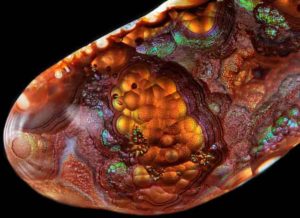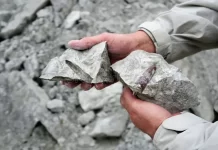
Fire Agate
The fire agate is a semi-precious natural gemstone which has only been discovered in certain areas of central, northern Mexico (New Mexico, Arizona and California) and in the southwestern United States (New Mexicans). These areas were subjected to massive volcanic activity during the Tertiary Period, around 24-36 million years ago.
Fire agate gemstone deposits were formed in these particular regions approximately 24-36 million years ago when the areas were subjected to massive volcanic activity during the Tertiary Period. Geological conditions within these different regions vary which produce differences in the type and style of fire agate found in each region. The agate formation, size, color and fire layer thickness all vary within these different geographic locations.
Ithave beautiful iridescent rainbow colors, similar to opal, with a Mohs scale hardness measurement of between 5 and 7 which reduces scratching when polished gemstones are put in jewellery. The vibrant iridescent rainbow colors found in fire agates, created by the Schiller effect as found in mother-of-pearl, are caused by the alternating layers of silica and iron oxide, which diffract and allow light to pass through and form a color interference within the stone’s microstructure layering causing the fire effect for which it is named.
Mohs scale hardness: 6 – 7
Color: Blue to yellow to red
Formula mass: 60 g / mol
Luster: Waxy, vitreous, dull, greasy, silky
Crystal system: Trigonal, monoclinic
How fire agate is formed?
It is a type of chalcedony (SiO2) which contains multiple, extremely thin layers of the iron oxide minerals of Goethite (FeO(OH)) and Limonite (FeO(OH)·nH20) imbedded within, and commonly completely enclosed by, semi-transparent to translucent layers of cryptocrystalline chalcedony. When cut and polished down to the layers containing the iron oxides, the stone displays a metallic, shimmering iridescence known as the Schiller Effect, where light is reflected and refracted off the various layers containing the Goethite and Limonite iron oxides to give the exquisite play of colors—or “fire”—for which the gemstone is named. Colors displayed by the “fire” vary greatly, the most common being shades of orangish brown, but also all shades and tones of yellow, orange, red, and green, and more rarely, purples and blues.
Is fire agate rare?
It is by far more rare than diamonds, emeralds or rubies. Gem quality which has been found only in the past sixty years in parts of California, Arizona and Mexico, making it the rarest, most colorful gem in the world.
Where is fire agate found?
The fire agate is a semi-precious natural gemstone which has only been discovered in certain areas of central, northern Mexico (New Mexico, Arizona and California)
The following is a list of some different minerals Sites . Some of these sites are open for public rockhounding and other are private mining claims or are situated on a restricted public country where any form of mineral collection is forbidden.
- Black Hills, Arizona – BLM Public Rockhounding Site
- Oatman, Arizona – Cuesta Fire Agate Mine
- Opal Hill, California – Opal Hill Fire Agate Mine
- Round Mountain, Arizona – BLM Public Rockhounding Site
- Saddle Mountain, Arizona – Outdoor Recreation and Fire Agate Rockhounding Site
- Deer Creek, Arizona, Fire Agate Location
- Slaughter Mountain, Arizona – San Carlos Apache Fire Agate Mine










